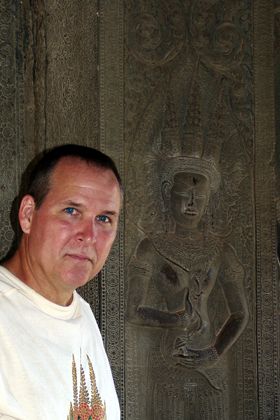Mysterious Khmer Devata Goddesses-Who were the Women of Angkor Wat?

Researcher Kent Davis theorizes that the many carved images of women found throughout the temple complex hold the key to the origins and purpose of the ancient monuments. Khmer Devata Goddesses-Who were the Women of Angkor Wat
Written by Jessie Beard – February 12, 2009
© 2009 The Phnom Penh Post – This article appears with the kind permission of the copyright holder. No further reproduction is permitted.

SIEM REAP, CAMBODIA – A TEAM of researchers, led by US educational program and marketing executive Kent Davis, is analysing 7,000 digital photos taken in November 2008 for a database that will attempt to unveil a mystery that’s been bugging Davis since he first visited Angkor Wat in November 2005.
He wants to determine why there are so many images of women in the temples, and he’s postulating a theory that Angkor wasn’t built to honour kings or gods, but to glorify women.
When Davis first came to Angkor, he immediately became fascinated by the carvings of women and instinctively felt they had been historically trivialised as decorations.
“I wasn’t prepared for the temple’s human side as realistic carvings of women greeted me. Quite clearly, the images of these women were a major part of the monument’s design and purpose,” he said.
“These women who are so extraordinary and so filled with significance that it’s incomprehensible they have remained unstudied and unappreciated in modern times. The fact that they have been hidden in plain sight during 150 years of intense Khmer scholarship is truly amazing.
“But a quantitative analysis could unlock the secrets these complex women have guarded for so long.”
Using a computer database, the project involves recording the diverse features of the women, enabling detailed analysis of them for the first time since they were carved.
Davis also departs from convention by referring to the women shown in temple carvings as devatas, not Apsaras.
“No one knows what the ancient Khmers called the women at Angkor Wat. I generally choose to use devata for historical and semantic reasons. About a hundred years ago, some scholars began using the Hindu term apsara, and that became more common over time.”
Davis’s use of the term devata and his quest to comprehensively analyse the collection of female carvings was also inspired by the work of a young French woman, Sappho Marchal, who began classifying the women by their attributes in her own personal drawings.
Marchal lived at Angkor Wat and was the daughter of the second curator of the Angkor Wat conservation program. She published a book, Costumes et parures Khmers d’apres les devata d’Angkor-Wat, in 1927, and when Davis discovered her writings, he became even more determined to finish what Marchal had started all those years ago.
Davis has already evaluated 259 carvings of women and expects to include over 1,800 carvings in his study. He said that once he amassed about 25,000 digital photos of the carvings he was studying, the sheer complexity required that a computer database be used.
But on April 17 last year, Davis’s project received a major setback – fire gutted his house and studio, destroying a collection of more than 2,000 books on the history of Southeast Asia. This included the manuscript he was preparing to republish, Angkor the Magnificent, originally written in 1924 by American socialite and Titanic survivor Helen Churchill Candee. [NOTE – Davis completed Angkor the Magnificent and it is now available on Amazon.com and Amazon.co.uk ]
The book is credited with introducing the concept of Cambodian tourism to Americans and Britons, and Davis’s revised version was scheduled to go to the publisher the day after the fire.
But the biggest setback was the destruction of Davis’s original notes and manuscripts on female statues at Angkor Wat, including 6 digital back ups of his 25,000 photos of the female carvings.
Not to be deterred, Davis returned to Angkor Wat last November to redo some photography.
“I had logistical help from three Cambodians and three European scientists in Cambodia. But due to the independent nature of the study, their contributions are unofficial.
“Now, the only limitations to progress are time and money. I have most of the photo data again and have built the database program. The process of preparing the images and inputting the data will be quite time-consuming.
“The first paper published will be a technical study I just completed with Michigan State University researchers using computer technology to analyse the faces of the 259 devata on the West Gopura.
“Beyond the database, I have an enormous amount of research data about the images in relation to Cambodian, Southeast Asian and South Asian culture. The introduction to this body of work will be published in the anthology to be called Daughters of Angkor Wat, through my publishing company DatAsia.
“Ultimately, my goal is to work with Cambodian researchers and the Apsara Authority.
“But the onus is on me to prepare substantial evidence before approaching them with my paradigm, which is that the primary reason Angkor Wat was built was to protect, honour and glorify these women, as well as the feminine principles that they represent.
“My view is that Angkor Wat is there because of the women.”
